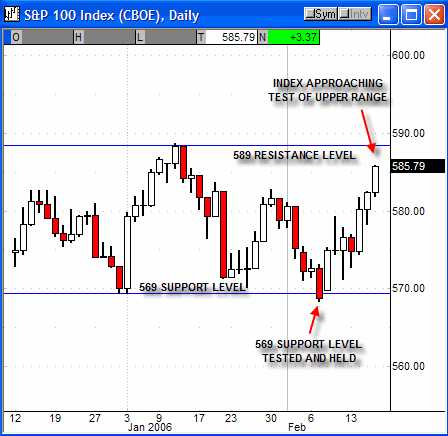If you like the buy side, wait for this level
The short-term market trend is up, and the intermediate-term market trend is up. The
(
XEO |
Quote |
Chart |
News |
PowerRating) (S&P 100) index traded higher on Thursday up 3.37 points to the 585.79 level. In reading the financial news, you would think that something significant had happened in financial markets over the past week as the Dow Jones Industrial index rose over the 11,000 level. In reality very little has happened in financial markets. As evidenced by the chart below, the S&P 100 index has been in a fairly wide trading range for over two months between the 569 and 589 levels on the S&P 100 index. Last week, the index successfully tested the lower end of its trading range and is now heading to the top of its trading range to test the upper limits.

From a longer-term perspective, the current movements in the stock market are not surprising. Here are the facts. The S&P 100 index closed at the 575.29 level on December 31, 2004. The index is trading at the 585.79 level presently, or up less than 2% in over a year. While very little has happened in financial markets for over a year, this does not mean that there were not excellent opportunities to profit with options. Options have the unique characteristic of being able to earn profits when the security underlying the options sits still by using the time depreciation characteristic of the options. This means that by selling options, one can profit when financial market conditions are static as they have been in the past year. Using the time depreciation characteristic of options, our recommendations have accrued over 127% in profits (excluding brokerage fees) since July 2004, without a single losing trade recommendation. We took a 6.6% profits on January 20th.
Bottom Line: It is likely that financial markets will remain in the trading range set forth in the short-term chart above. This means that traders can look to execute long positions when the S&P 100 index declines to the 569 level, and seek to take profits, or enter short positions when the index rises to the 589 level. Additionally, options traders should seek to sell time premium to benefit from stagnant financial markets. Tight stops should be used to ensure that financial markets don’t break below the 569 level or rise above the 589 level on a sustained basis. One other note: I will be giving an online options seminar on Thursday, February 23rd at 11 a.m. EST. to discuss more fully successful options trading. Hope you can join us.
Sincerely, Charles Sachs Chief Options Strategist
Charles Sachs has utilized S&P 100 for the past 14 years, both as a trader and an advisor. He uses 24 proprietary indicators in order to structure options strategies which can generate gains whether the market moves up, down or sideways.
